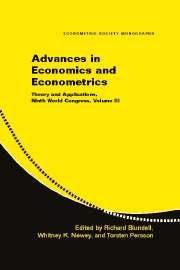Book contents
- Frontmatter
- Contents
- Contributors
- Introduction by the Editors
- 1 Identification of Nonadditive Structural Functions
- 2 Nonadditive Models with Endogenous Regressors
- 3 Heterogeneity and Microeconometrics Modeling
- 4 Heterogeneous Choice
- 5 Modeling Heterogeneity
- 6 Inference with Weak Instruments
- 7 Empirical Likelihood Methods in Econometrics: Theory and Practice
- 8 Weak Instruments and Empirical Likelihood: A Discussion of the Papers by D. W. K. Andrews, J. H. Stock, and Y. Kitamura
- 9 Estimating Continuous-Time Models with Discretely Sampled Data
- 10 Variation, Jumps, and High-Frequency Data in Financial Econometrics
- 11 Discussion of Aït-Sahalia and Barndorff-Nielsen and Shephard
- 12 Understanding Bias in Nonlinear Panel Models: Some Recent Developments
- 13 Fixed and Random Effects in Nonlinear Panel Data Model: A Discussion of a Paper by Manuel Arellano and Jinyong Hahn
- Index
- Titles in the series
1 - Identification of Nonadditive Structural Functions
Published online by Cambridge University Press: 05 January 2013
- Frontmatter
- Contents
- Contributors
- Introduction by the Editors
- 1 Identification of Nonadditive Structural Functions
- 2 Nonadditive Models with Endogenous Regressors
- 3 Heterogeneity and Microeconometrics Modeling
- 4 Heterogeneous Choice
- 5 Modeling Heterogeneity
- 6 Inference with Weak Instruments
- 7 Empirical Likelihood Methods in Econometrics: Theory and Practice
- 8 Weak Instruments and Empirical Likelihood: A Discussion of the Papers by D. W. K. Andrews, J. H. Stock, and Y. Kitamura
- 9 Estimating Continuous-Time Models with Discretely Sampled Data
- 10 Variation, Jumps, and High-Frequency Data in Financial Econometrics
- 11 Discussion of Aït-Sahalia and Barndorff-Nielsen and Shephard
- 12 Understanding Bias in Nonlinear Panel Models: Some Recent Developments
- 13 Fixed and Random Effects in Nonlinear Panel Data Model: A Discussion of a Paper by Manuel Arellano and Jinyong Hahn
- Index
- Titles in the series
Summary
INTRODUCTION
When latent variates appear nonadditively in a structural function the effect of a ceteris paribus change in an observable argument of the function can vary across people measured as identical. Models that admit nonadditive structural functions permit responses to policy interventions to have probability distributions. Knowledge of the distributions of responses is important for welfare analysis and it is good to know what conditions secure identification of these distributions. This lecture examines some aspects of this problem.
Early studies of identification in econometrics dealt almost exclusively with linear additive “error” models. The subsequent study of identification in nonlinear models was heavily focused on additive error models until quite recently and only within the last ten years has there has been extensive study of identification in nonadditive error models. This lecture examines some of these recent results, concentrating on models which admit no more sources of stochastic variation than there are observable stochastic outcomes. Models with this property are interesting because they are direct generalizations of additive error models and of the classical linear simultaneous equation models associated with the work of the Cowles Commission, and because the addition of relatively weak nonparametric restrictions results in models which identify complete structural functions or specific local features of them.
Nonparametric restrictions are interesting because they are consonant with the information content of economic theory. Even if parametric or semiparametric restrictions are imposed when estimation and inference are done, it is good to know nonparametric identification conditions because they tell us what core elements of the model are essential for identification and which are in principle falsifiable.
Information
- Type
- Chapter
- Information
- Advances in Economics and EconometricsTheory and Applications, Ninth World Congress, pp. 1 - 16Publisher: Cambridge University PressPrint publication year: 2007
Accessibility standard: Unknown
Why this information is here
This section outlines the accessibility features of this content - including support for screen readers, full keyboard navigation and high-contrast display options. This may not be relevant for you.Accessibility Information
- 2
- Cited by
